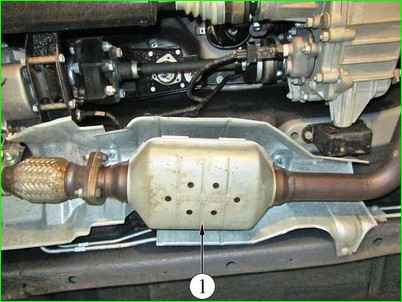To comply with Euro-5 standards for the content of harmful substances in exhaust gases, it is necessary to use a catalytic converter in the exhaust system
To comply with Euro-5 standards, an additional muffler 21230-1200018-50 with a 21230-1206026-50 converter is used.

Using a catalytic converter provides a significant reduction in hydrocarbon, carbon monoxide and nitrogen oxide emissions with exhaust gases provided that the combustion process in the engine is precisely controlled.
To speed up the process of converting hydrocarbons, carbon monoxide and nitrogen oxides into non-toxic compounds, the neutralizer has an oxidation and reduction catalyst.
The oxidation catalyst is platinum.
It promotes the oxidation of hydrocarbons and carbon monoxide contained in the exhaust gases into water vapor and carbon dioxide.
The reduction catalyst is rhodium.
It accelerates the chemical reaction of reducing nitrogen oxides into harmless nitrogen, which is one of the components of air.
Oxygen is required to neutralize hydrocarbons and carbon monoxide.
Nitrogen oxides are reduced at the same time.
Therefore, for the neutralizer to operate efficiently, it is necessary to precisely maintain the balance of the fuel and air supplied to the engine. mixtures.
High residual oxygen content in exhaust gases (during lean combustion) makes it difficult to reduce nitrogen oxides.
Low oxygen content in exhaust gases (during rich combustion) makes it difficult to oxidize carbon monoxide and hydrocarbons.
Only an accurate balance of the air-fuel mixture ensures effective neutralization of all three toxic components.
The most complete combustion of the air-fuel mixture and the most effective neutralization of the above-mentioned toxic components of exhaust gases are ensured with an air-to-fuel ratio of 14.5-14.6:1, i.e. 14.5-14.6 kg of air per 1 kg of fuel.
When operating a faulty engine, the neutralizer may fail due to thermal stress (above 970 °C), to which it is exposed during oxidation of excess amounts of hydrocarbons.
Under thermal stress, the ceramic blocks of the neutralizer may be destroyed (clogged), causing an increase in exhaust gas pressure.
A possible cause of neutralizer failure is the use of leaded gasoline.
The tetraethyl lead contained in it leads to poisoning of the neutralizer in a short time, which significantly reduces its efficiency.
Also, the cause of neutralizer failure is the use of gaskets containing silicone, and the use of non-recommended types of motor oils with a high content of sulfur and phosphorus.
Diagnostics of the neutralizer condition is carried out by the controller, which compares the signals from the oxygen sensors before and after the neutralizer.
If a decrease in the efficiency of the neutralizer is detected, which can cause the amount of harmful emissions to exceed the Euro-5 standards, the controller generates a corresponding fault code and turns on the alarm.





